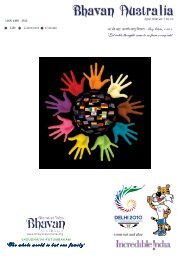World Peace - Bharatiya Vidya Bhavan Australia
World Peace - Bharatiya Vidya Bhavan Australia
World Peace - Bharatiya Vidya Bhavan Australia
Create successful ePaper yourself
Turn your PDF publications into a flip-book with our unique Google optimized e-Paper software.
The proportionate presence of<br />
the five proelements contributes<br />
to the formation of Rasa (taste).<br />
A Dravya may exhibit one<br />
Rasa such as Madhura (sweet)<br />
in the case of sugar or up to five<br />
Rasas in the case of fruits such<br />
as Haritaki, where all Rasa except<br />
Lavana (saline) are present.<br />
their nutritional or therapeutic effects. The therapeutic<br />
effects are classified according to causative factors,<br />
manifested conditions, or both.<br />
Substances are generally classified based on the origin<br />
of the substance, the specific therapeutic action, those<br />
having more than one effect, and the treatment applications.<br />
Authors belonging to different periods have<br />
followed different methods of classification. Later<br />
books provide a comprehensive compilation of drugs<br />
under different categories. For the most part, groups of<br />
drugs are named based on similar therapeutic actions,<br />
effects, or after a representative substance.<br />
Charaka Samhita, the most ancient Ayurvedic text,<br />
describes 50 groups of 10 plants each classified according<br />
to their therapeutic actions such as Jwaragna<br />
(antipyretics) or Mutral (diuretics) and specific applications<br />
such as Vamana (emesis) or Virecana (purgation).<br />
Sushruta, author of another treatise, describes<br />
38 groups of plants with similar properties such as<br />
Ropan (wound healing), Shothagna (anti-inflammatory),<br />
Stanyajanan (galactagogue), or Arshogna (antihemorrhoidal).<br />
These texts indicate knowledge about<br />
therapeutic actions or effects of different drugs or<br />
substances similar to present-day pharmacology.<br />
However, the terms Guna (properties), Rasa, Virya,<br />
Vipaka, and Prashava, which describe different actions<br />
or effects of a Aushadhi (drug), require proper<br />
clinical interpretation.<br />
Aushadhi Karan<br />
(Pharmaceutics)<br />
The knowledge about pharmaceutics is well developed.<br />
Knowledge is available for the use of the juice<br />
of the fresh plant to that of powder, pills, infusions,<br />
34 | <strong>Bhavan</strong> <strong>Australia</strong> | August 2012<br />
medicinal oils, medicinal wines, and so forth as well<br />
as external application. Specific processes for detoxification<br />
of toxic substances and enhancement of the<br />
therapeutic actions are described in detail. In most<br />
cases, multiple composition and variety of the pharmaceutical<br />
process provides extensive flexibility to<br />
allow for the selection of a specific type of medicine<br />
or treatment.<br />
In Ayurvedic literature, thousands of formulations are<br />
described with details of composition, quantity,<br />
process, general effect on humors, and specific clinical<br />
indications. Although plants are more commonly<br />
used as therapeutics, the use of metals such as gold,<br />
zinc, or copper and minerals such as mica or iron ores<br />
is not uncommon. Metals are processed specifically to<br />
ensure safety and to enhance their therapeutic effects.<br />
Quality and Administration of Drugs<br />
Essentially, an ideal drug restores equilibrium or<br />
functional harmony. Any procedure which induces a<br />
therapeutic response is expected to not create any<br />
untoward side-effects. Due to its natural origin, a<br />
therapeutic should be available in abundance, rich in<br />
specific properties, have multiple uses, and be able<br />
to deliver the desired effect.<br />
Safety and efficacy concepts are well defined. A drug<br />
or medicine is required to be examined in terms of its<br />
genesis, property, efficacy, seasonality, time of acquisition<br />
or procurement, preservation, and modification<br />
or process. Its application must be understood<br />
in terms of administration, dosage, patient compliance,<br />
and specific therapeutic effect. It is also necessary<br />
to understand its use in combination with other<br />
drugs and to compare it with other medicines with<br />
similar properties.<br />
A medicine is considered appropriate if it can be given<br />
in small doses, has a rapid onset of action, and is easy<br />
to assimilate. It should be curative of a specific disease<br />
or increased morbidity and be safe even in complicated<br />
disease conditions. It should not have a depressant<br />
effect on metabolism, and it should be palatable,<br />
pleasing, and have good taste, odor, and color.<br />
The time of administration of medicines is well specified,<br />
especially in relation to meals in the case of oral<br />
medicines. There are 10 different timings prescribed<br />
based on the clinical indications: empty stomach<br />
(early morning), premeal, midmeal, postmeal, between<br />
two major meals (midday), with meals, and<br />
so on. The importance of time in relation to specific<br />
therapeutic effects is also mentioned. For example,<br />
medicines for anxiety disorders are









